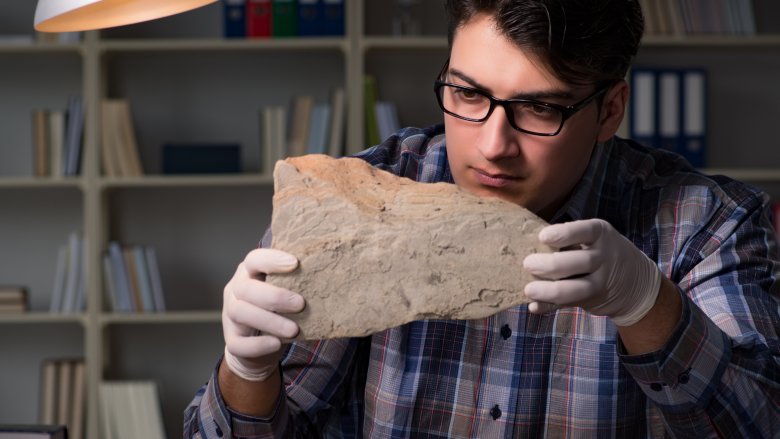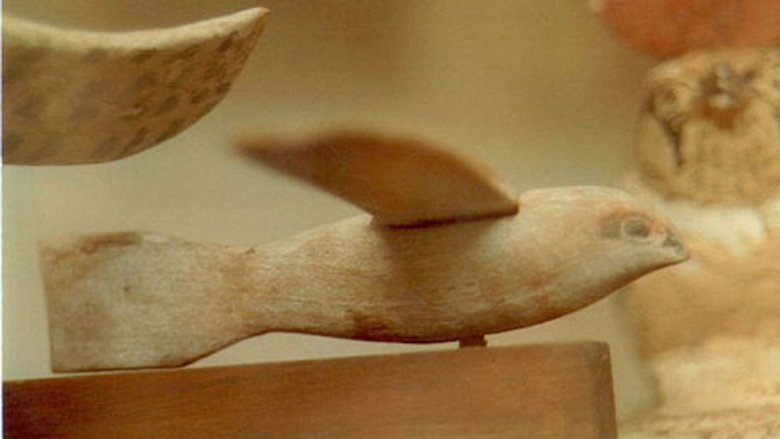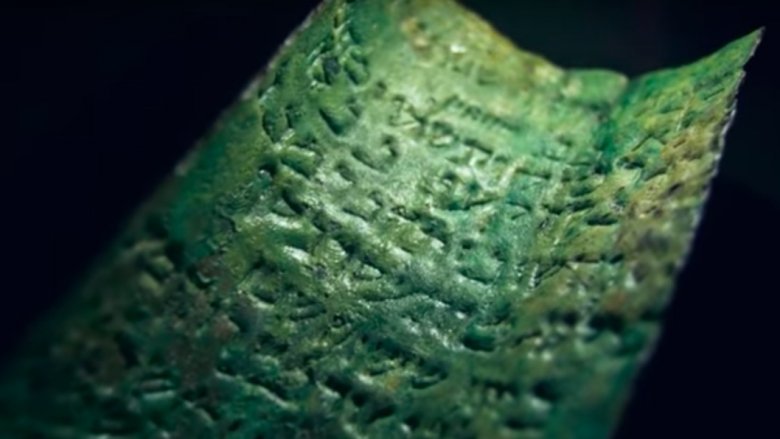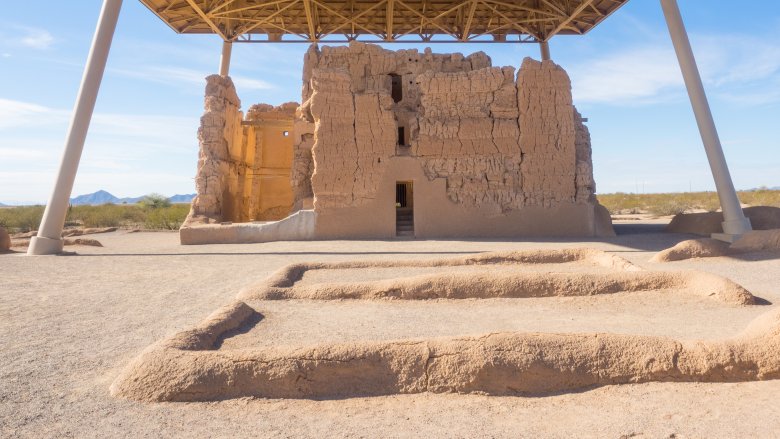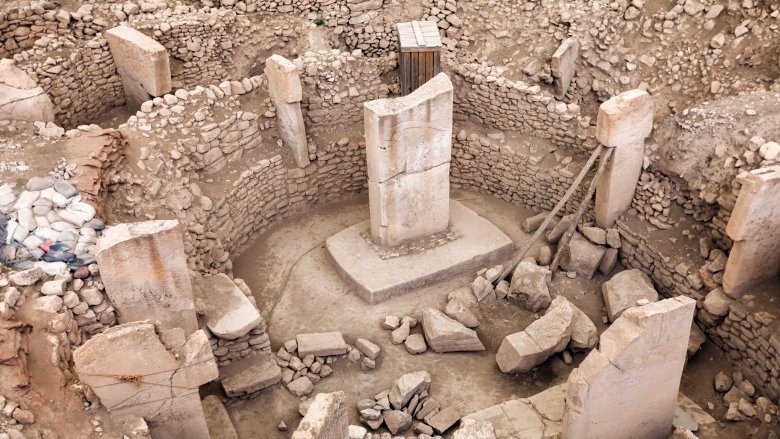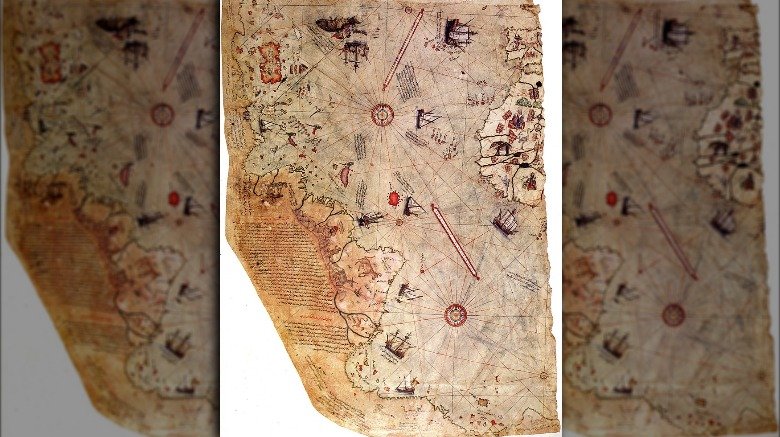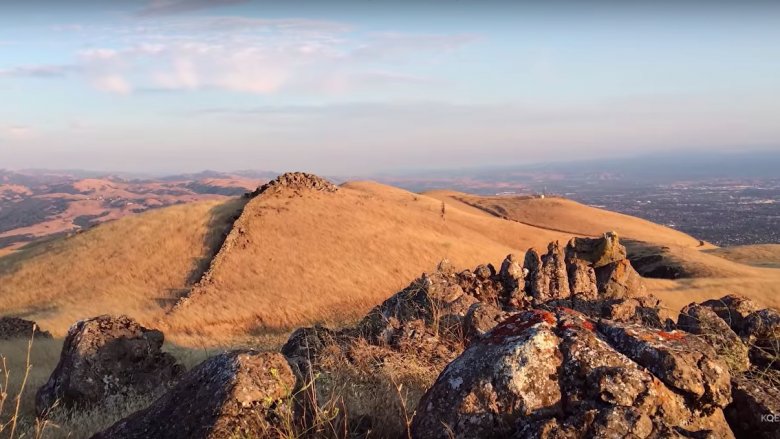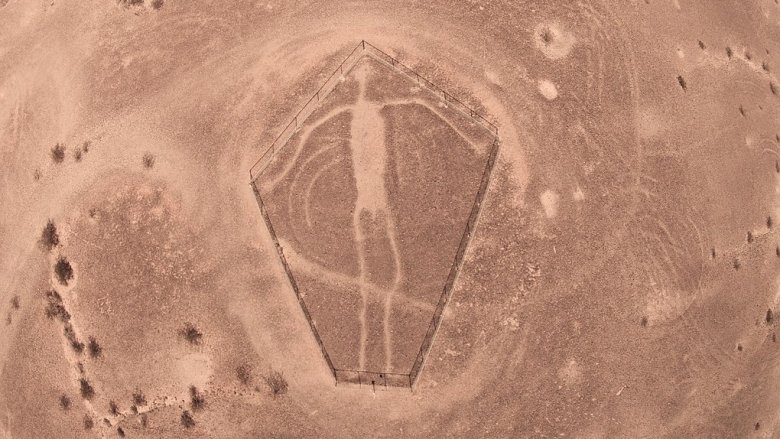Ancient Discoveries That Nobody Can Explain
The trouble with history is that it's only as good as the people who write it down. And up until relatively recently, no one was writing anything down because written languages didn't exist. And even after written languages became a thing, well, you couldn't really trust those ancient historians to avoid the temptation of embellishment and outright fabrication. After all, it's not like they had Politifact to keep them all in line or anything.
So it makes sense that a lot of ancient history is still a mystery to us. We might have the ancient artifacts, but because their creators couldn't package them with instruction manuals or product descriptions, there are a lot of cases where we just don't have any idea what those objects or monuments were for or what those drawings or maps really represented.
Museums and textbooks are full of examples of these sorts of ancient objects and places, and there are really too many of them to cover them all. But just for fun, here are some of the craziest ancient discoveries.
An ancient model of ... an airplane?
"Aliens built the pyramids" theorists love this artifact because at first glance it kind of looks like it was created by a time-traveling ancient Egyptian or someone with some serious knowledge of aerodynamics.
According to Ancient Origins, the Saqqara bird was discovered in 1898 in the Padiimen tomb. It's roughly 2,200 years old and it looks, frankly, like an airplane with a bird's head. Also, papyrus documents found near the artifact contain the words "I want to fly." That's led certain people, including the guy who found the thing in 1898, to hypothesize that the Saqqara bird is actually a model of a literal airplane that the ancient Egyptians either built themselves or saw someone else fly. In fact a couple people have tested working replicas of the Saqqara bird and say that it would have been capable of generating lift.
Sometimes these little projects kind of just prove what everyone wants them to prove, though, and not every reproduction of the Saqqara bird has had similarly wowing results. In 2002 a glider designer named Martin Gregorie made a working model of the Saqqara bird, which demonstrated that the bird would have needed a tail wing stabilizer (missing on the original model) in order to fly and that even with that addition it was still not super aerodynamic. That more supports the theory that the Saqqara bird was a toy that coincidentally happened to resemble an airplane. Thanks for pooping on that party, Martin.
Specific directions to ancient treasure no one can actually find
The Dead Sea Scrolls are already mysterious — some of the text found in the scrolls predates the Old Testament of the Bible by 1,000 years, and most of what it says about New Testament times isn't even found in the New Testament. So what would make the Dead Sea Scrolls even more mysterious? How about a treasure map printed on copper?
According to Ancient Origins, the Copper Scroll or "3Q15" was the last of 15 scrolls discovered in Cave 3 at Qumran. It was obviously unique just because it was written on metal (the rest of the scrolls were written on parchment or papyrus). And it was written in a different type of Hebrew than the other scrolls, too. Also, it wasn't a work of literature like the others, but a list.
Okay, but what kind of list? Well, it was a list of precious metals with a modern estimated value of around a billion dollars. Also, it included directions to all 64 locations where the treasure could be found. So certainly someone was like, "Sweeeeeet we're rich!" but alas, the directions are vague and contain references to obscure locations like "the old washer's chamber" and "Matia's courtyard," and to date no one has been able to figure out where the heck those places are. And despite many treasure-seeking expeditions, the scroll has failed to turn up a single hoard of silver and gold. Dang.
A bizarre, undeciphered not-so-ancient manuscript
This book isn't exactly "ancient," but it certainly is weird, and the fact that it isn't especially ancient actually makes it all the more weird. The 15th and 16th centuries weren't the Dark Ages, and we know a lot about what was happening in the world at that time and, more precisely, who was speaking and writing in what languages. That's what makes the Voynich Manuscript so bizarre — it wasn't written during a super-ancient time period, it was written at the end of the 15th century or the 16th century, and it's baffled historians and researchers for more than a century.
According to the Beinecke Rare Book and Manuscript Library, the Voynich Manuscript is full of vivid illustrations of botanicals (including 113 unidentified plants), astronomical and astrological drawings and charts, drawings of medicinal herbs and roots, pages of text written in an unknown language, and miniature female nudes, because of course.
To date there have been several attempts to crack the manuscript's code. None have provided a complete translation, though, and most of them have been dismissed or criticized by other scholars. In July 2019, yet another team announced that they'd "unlocked the door," but another scholar poo-pooed their announcement. "I can say without reservation that their proposal is not new to Voynich research, and it cannot possibly be correct," said a Cambridge scholar after reviewing the new claim. Oh well, back to the drawing board.
A gigantic ancient mound in the shape of a serpent
The Great Serpent Mound in Ohio certainly seems like it must have had some purpose, but no one has more than a vague theory about what its purpose might have actually been. According to Ancient Origins, the mound is 1,300 feet long and 3 feet high and might have been built around 1070 A.D., though it's hard to say for sure since that date is based on radiocarbon testing of some charcoal found inside the mound — and really, there's no proof that the charcoal didn't end up there years or even centuries after the thing was built.
The mound is made out of clay and ash and was reinforced with stone, and it's generally thought to represent a serpent with an open mouth, which is about to eat an egg or possibly the Sun. Other theorists think the mound actually represents an eclipse or the phases of the Moon. There is some evidence that the mound is astronomical — research conducted in 1987 found that the head/egg part of the mound aligned to sunset at summer solstice, which means it could have served as a calendar. But it might have had a more sinister purpose, too. At one time there was a blackened stone monument in the egg part of the mound, and since then numerous headless skeletons were found buried nearby, as well as ceremonial knives and blackened stones. So lots of mystery, and no conclusive proof.
A strange underwater monument
Sometimes it kind of seems like ancient people built all their temples and mounds and effigies just so they could bask in the satisfaction of knowing that in the distant future someone was going to waste a whole bunch of time trying to figure out what those temples and mounds and effigies were actually for.
In the summer of 2003, researchers were conducting a sonar survey of the southwest portion of the Sea of Galilee in Israel when they discovered a submerged circular structure made of huge basalt boulders. Weirdly, there appeared to be no order to the placement of the boulders, but still, the structure was definitely made by humans and was probably originally built on land before it was eventually swallowed up by rising waters. Researchers tentatively labeled it a "cairn," which is a mound of rough stones that might have once served as a landmark or a memorial.
According to Live Science, some researchers think the structure dates back 4,000 years. The effort to build such a thing would have been monumental for the people of that era, which suggests that the cairn could only have been built by a wealthy, well-organized society. Honestly, maybe it was just a bunch of bored elders hoping to mess with their descendants in a few centuries. If you listen really carefully, you can almost hear the sound of their ancient laughter as they imagine how much time we'd all be wasting on their stupid little pile of rocks.
A mysterious ancient structure in Arizona
Ancient structures and monuments typically call to mind places like Europe, Asia, and the Middle East, where old stone castles, temples, and walls have been intriguing archaeologists since the beginning of archaeology. But the Americas are rich with archaeological treasures, too. One such place is Casa Grande in Arizona, which probably dates to 1350 and is one of the largest pre-Columbian structures in North America.
According to the National Park Service, archaeologists still haven't figured out what Casa Grande was actually for. The structure is four stories tall and was likely abandoned just 100 years or so after it was built, since it was already in ruins when it was first described by a Jesuit missionary in 1694. There's evidence that an advanced civilization was living in the area at the time of Casa Grande's construction — they had irrigation technology and broad trade connections and were probably also the builders of Casa Grande.
There's some speculation that the structure might have been used as a municipal hub or was perhaps even the home of a wealthy family. It has a ball court, but it also has features that would have allowed for the observation of the equinoxes, summer solstice, and lunar standstill. But alas, the civilization that built Casa Grande had no written language, and therefore couldn't leave behind any description of the structure and its use, so we'll never really know what its purpose was.
The rise of civilization ... or maybe not
In the 1960s, a site full of broken slabs of limestone in southeastern Turkey was described by University of Chicago and Istanbul University anthropologists, who dismissed it as an abandoned medieval cemetery. They were wrong, though. So wrong. According to Smithsonian, Gobekli Tepe is actually an 11,000-year-old site.
Gobekli Tepe now sits in an empty, lifeless landscape, but at one time the land would have been full of water, fruit and nut trees, and herds of wild animals. It was the sort of place that would have attracted human nomads, and it's possible that some of them decided to settle there and build a holy site. If that's true, it would change what we understand about the rise of civilization — it would mean that humans built temples before they developed agriculture, and we've assumed for a long time that those things happened in the opposite order.
Not everyone agrees, though. Some archaeologists insist there's no evidence that anyone ever lived at Gobekli Tepe. And the carvings on the stones are kind of fantastic and scary — spiders, lions, snakes, and scorpions dominate, which might suggest that the site was not a civilization but simply a place where hunter/gatherers could symbolically confront the dangers of their world. Because the site predates written language by 6,000 years, though, once again we can only guess as to what might have actually been going on at Gobekli Tepe 11,000 years ago.
An ancient city built on a coral reef
If you were going to build a city, you'd probably find yourself a nice, flat area, preferably nowhere near an earthquake-prone fault line or a swamp or a place that's prone to tornadoes or sinkholes. At the very least, you'd make sure that your city was on solid ground because cities built on solid ground don't usually just fall over.
The builders of Nan Madol gave themselves no such limitations, though. They built their 200-acre city on top of a coral reef, and the ruins are so bizarre and unlikely that the locals think the place is haunted and archaeologists think it's unfathomable. The city's stone structures are so heavy that no one has been able to come up with a reasonable explanation for how they were transported or lifted.
According to Smithsonian, the city was built between the 13th and 17th centuries out of columns of lava rock, which were arranged log-cabin style to construct walls and foundations. One of the most impressive constructions is the royal mortuary, which is larger than a football field, sports 25-foot walls, and has a cornerstone that weighs around 50 tons. In fact the total estimated weight of all of Nan Madol's rocks is said to be around 750,000 metric tons. The locals are pretty sure the construction was done with magic, and frankly, that almost sounds like a reasonable conclusion.
A map that showed Antarctica way before anyone knew about Antarctica
In 1929 a German theologian named Gustav Deissmann found a map in a pile of discarded items. The map had been drawn on a piece of gazelle-skin parchment by a Turkish cartographer, and it appeared to include Antarctica. But here's the weird part — the map was drawn nearly 300 years before Antarctica was discovered. And what's more, the Antarctica as it appears on the map looks the way it would have looked 6,000 years ago, before it was covered with ice. And what's even more, the map appears to have been drawn with a map-making method that wasn't even in use at the time.
According to the Vintage News, some scholars thought the Piri Reis map was proof that an advanced civilization existed prior to 4,000 B.C. — one with mapmaking, navigation, and nautical skills. One scholar who studied the map in the 1960s even claimed the drawing was so accurate that the civilization had to have also possessed the ability to view the coastline from the air.
That sounds pretty ludicrous, but other theorists haven't really been able to provide a logical alternative. They say that the part of the map assumed to be Antarctica is actually the lower portion of South America, but that doesn't really explain why the mapmaker put it at the bottom part of the map, where Antarctica is supposed to go. So let's just say it was aliens. It's more fun that way.
Mystery walls near Berkeley, California
Mystery walls exist all over the world, some of them so old that no one can remember who put them there and why. Even California has a mystery wall (and we don't mean the one on the southern border).
According to Atlas Obscura, the Berkeley Mystery Walls run across the California hills from Berkeley to San Jose. They're made from randomly sized boulders, some weighing up to a ton, and they run in strange, broken sections. Some of the sections are short, only a few yards in length, while others are up to a half mile long. Some are in bizarre, inaccessible places, and none of them are really tall enough to have a utilitarian purpose. And because the mere existence of these walls isn't weird enough, they eventually lead to some bizarre stone circles and a 200-foot wide spiral that circles a large boulder.
So what the heck? Bored hippies in the '60s maybe? Nope. The first Europeans settlers reported that the walls predated their arrival, and evidently the local Ohlone tribe said the stones predated their arrival, too. Some people think they're a sign that an advanced civilization once lived in the Oakland hills. Others think they were built by pre-European settlers from Mongolia, or by colonists who were left there by Sir Francis Drake. All fun theories, none of which can be definitely excluded. Except the one about the bored hippies.
Huge symbols carved into the Earth
There are lots of examples of ancient cave paintings, petroglyphs, and other ancient symbols and carvings that were clearly meant as either grand works of art, religious symbolism, or maybe even a way to speak to people across the centuries. But we don't really know because the civilizations who made all those symbols had no written language, so they couldn't exactly caption their work.
Intaglios are common in the American Southwest and South America — they aren't just symbols, they are huge pictures of humans or anthropomorphic animals that are carved into the Earth. Some of them are so big that they can't be identified from the ground. America's most famous example are the Blythe intaglios, which are located in the desert outside Blythe, California.
According to Atlas Obscura, the intaglios weren't discovered by non-natives until 1932, when a pilot spotted them from the air. There are a total of six different figures — some are animal but most are human, and the largest human is 171 feet long. Researchers think they're between 450 and 2,000 years old. No one knows the meaning or purpose of the intaglios, though there are plenty of theories. In the prevailing one, the glyphs tell the ancestral Chemehuevi story of the creation, but all we really know for sure is that they're old and awe-inspiring. And for the intaglios and many of the other ancient sites and artifacts on this list, that might just have to be enough.
